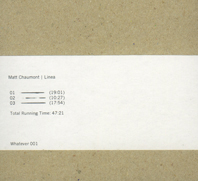www.avantwhatever.com
 |
Australian artist Matt Chaumont has spent the better part of the last decade immersed in the world of low frequency sounds, producing a range of works that have probed that liminal perceptual zone where hearing and touch intersect. This has regularly involved the construction and installation of custom-built speaker systems capable of delivering sounds well below the threshold of human hearing and at a volume sufficient for Chaumont’s needs. So with the release of Linea we find out how his aesthetic and practice translates to the home listening CD/album format.
Linea comprises three pieces that are constructed using a limited set of resources—low frequency sine tones. However, this is not to say that these works are in any way austere or simply reductionist. Instead, Linea explores that territory common to the early Minimalist composers such as La Monte Young, Tony Conrad and Charlemagne Palestine, the early work of Ryoji Ikeda and the sine-tone pieces by Alvin Lucier, where reductive strategies generate complex outcomes. Each of Chaumont’s works on this CD produces an intricate sound derived from the interactions between his spare source materials. These works are in no way fast moving—all three pieces are marked by a certain stasis of form, allowing listeners plenty of opportunity to bask in the low, low sounds.
Track one begins by gently shuddering up from below the threshold of audibility before settling into a deep throb, the result of acoustical beats formed by the relationship between two or more tones close together in frequency, the effect of which is somehow both restful and disturbing. As the tones gradually fall in frequency towards the end of the piece, the ear is seemingly dragged into lower and lower pitch zones until the roles of hearing and feeling the sound are well and truly conflated. The second track is both richer and subtler, with incremental harmonic shifts between chordal structures, punctuated with occasional 'silences' produced by sub-audible tones. The last piece returns to a realm of deep pulsations, which gradually mutate and expand over its duration.
It is almost a cliché to say that works such as these that utilise low frequency sound are in some way inherently invested with notions of the physical, especially as very low frequency sounds (typically those below 20 Hertz) are largely perceived through, and interpreted as, touch. However, sounds of all frequencies are equally physical phenomena, and impinge upon our bodies in myriad ways regardless of our modes of perception. What is more interesting about Chaumont’s work is the number of ways that it engages its audience across the perceptual scheme. A sense of physicality is induced not just by the sensation of sound vibrating the ear drum, body or furniture but in the way it arranges itself in space, marking the physical relationship between the listener and the waves of sound in the room. Likewise, the movement of the loudspeaker cones is discernable to the eye (if not the ear), adding a significant visual component to these pieces, especially during periods of what otherwise is experienced as silence. More than the sensational, but rather simplistic, subsonic thump in the thorax one feels from the kick drum in a night club or rock concert, Chaumont’s work demonstrates that even without the benefit of concert sized sound systems or home theatre sub woofers, low frequency sound is more than the sonic equivalent of the fun park ride—some overpowered gimmick for quick excitement. Instead, it becomes not just a malleable tool for mingling the senses, but also a conceptual space for reappraising the everyday division of the senses into discrete realms: sight, sound, space and touch—all from the slow and steady vibration of speaker cones.
Peter Blamey
© Peter Blamey; for permission to reproduce apply to [email protected]








 back
back